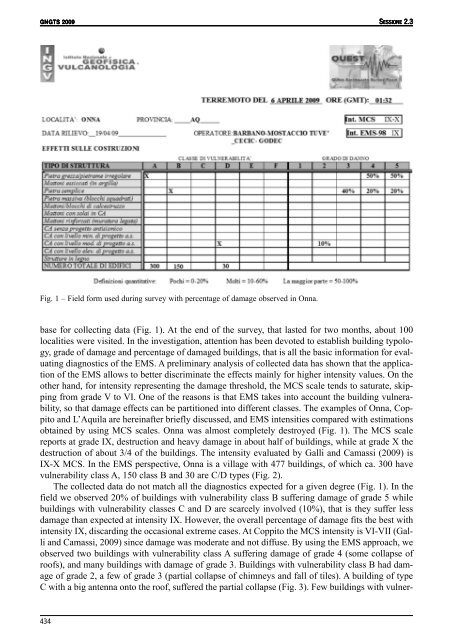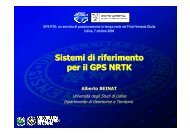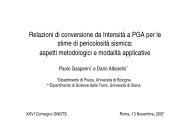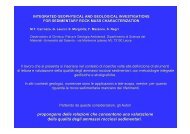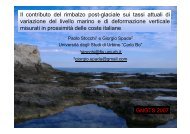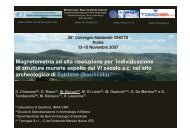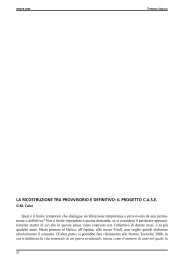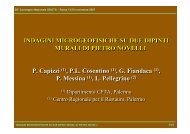Create successful ePaper yourself
Turn your PDF publications into a flip-book with our unique Google optimized e-Paper software.
GNGTS 2009 SESSIONE <strong>2.3</strong><br />
Fig. 1 – Field form used during survey with percentage of damage observed in Onna.<br />
base for collecting data (Fig. 1). At the end of the survey, that lasted for two months, about 100<br />
localities were visited. In the investigation, attention has been devoted to establish building typology,<br />
grade of damage and percentage of damaged buildings, that is all the basic information for evaluating<br />
diagnostics of the EMS. A preliminary analysis of collected data has shown that the application<br />
of the EMS allows to better discriminate the effects mainly for higher intensity values. On the<br />
other hand, for intensity representing the damage threshold, the MCS scale tends to saturate, skipping<br />
from grade V to VI. One of the reasons is that EMS takes into account the building vulnerability,<br />
so that damage effects can be partitioned into different classes. The examples of Onna, Coppito<br />
and L’Aquila are hereinafter briefly discussed, and EMS intensities compared with estimations<br />
obtained by using MCS scales. Onna was almost completely destroyed (Fig. 1). The MCS scale<br />
reports at grade IX, destruction and heavy damage in about half of buildings, while at grade X the<br />
destruction of about 3/4 of the buildings. The intensity evaluated by Galli and Camassi (2009) is<br />
IX-X MCS. In the EMS perspective, Onna is a village with 477 buildings, of which ca. 300 have<br />
vulnerability class A, 150 class B and 30 are C/D types (Fig. 2).<br />
The collected data do not match all the diagnostics expected for a given degree (Fig. 1). In the<br />
field we observed 20% of buildings with vulnerability class B suffering damage of grade 5 while<br />
buildings with vulnerability classes C and D are scarcely involved (10%), that is they suffer less<br />
damage than expected at intensity IX. However, the overall percentage of damage fits the best with<br />
intensity IX, discarding the occasional extreme cases. At Coppito the MCS intensity is VI-VII (Galli<br />
and Camassi, 2009) since damage was moderate and not diffuse. By using the EMS approach, we<br />
observed two buildings with vulnerability class A suffering damage of grade 4 (some collapse of<br />
roofs), and many buildings with damage of grade 3. Buildings with vulnerability class B had damage<br />
of grade 2, a few of grade 3 (partial collapse of chimneys and fall of tiles). A building of type<br />
C with a big antenna onto the roof, suffered the partial collapse (Fig. 3). Few buildings with vulner-<br />
434


